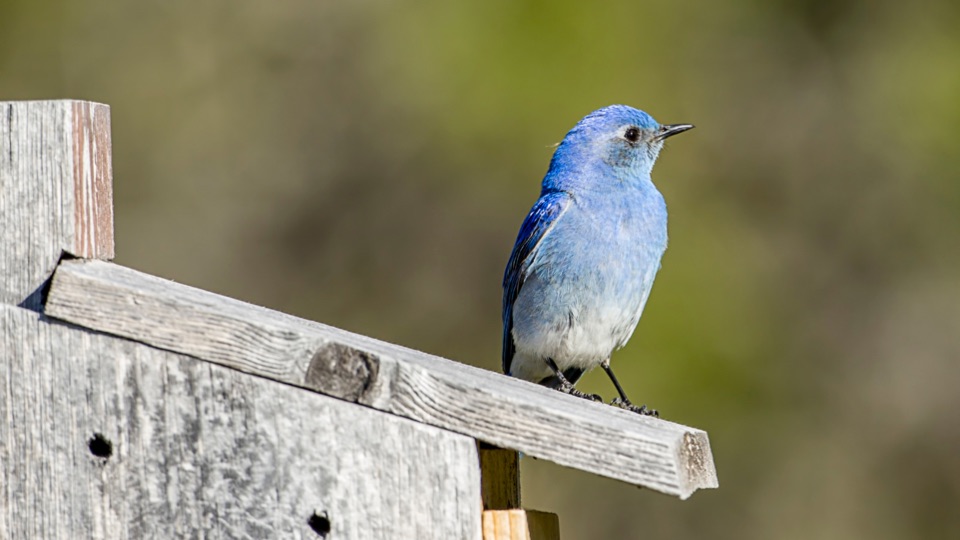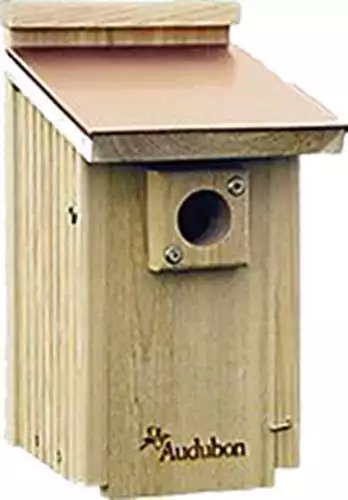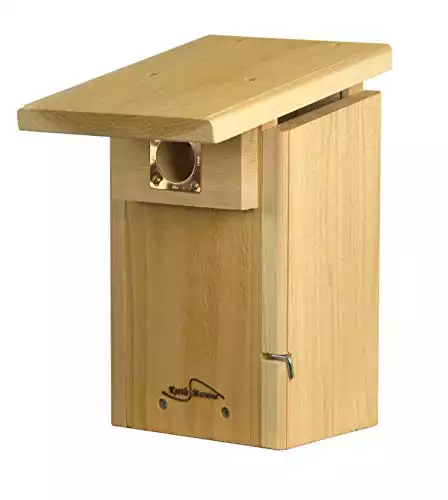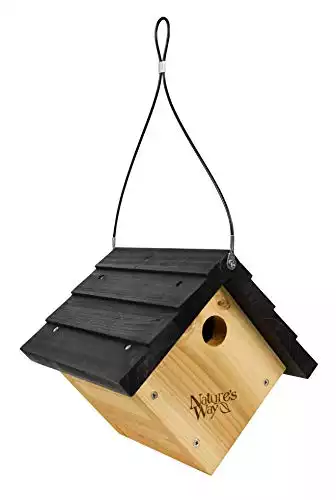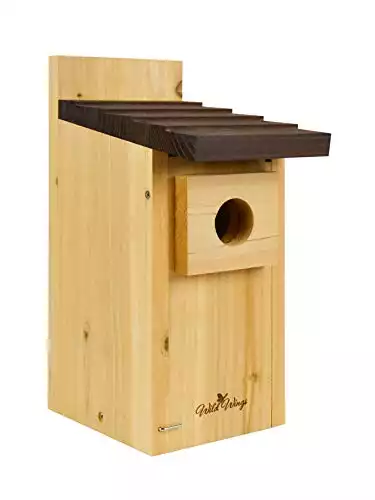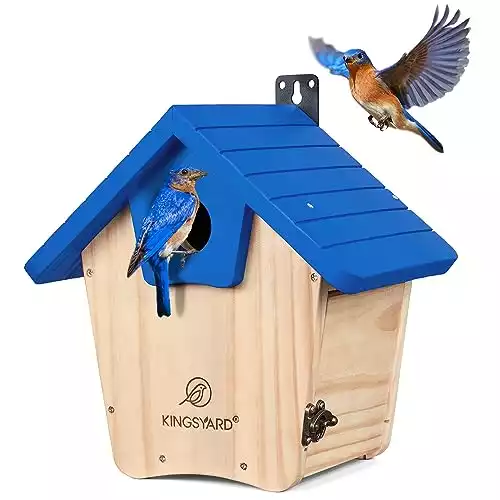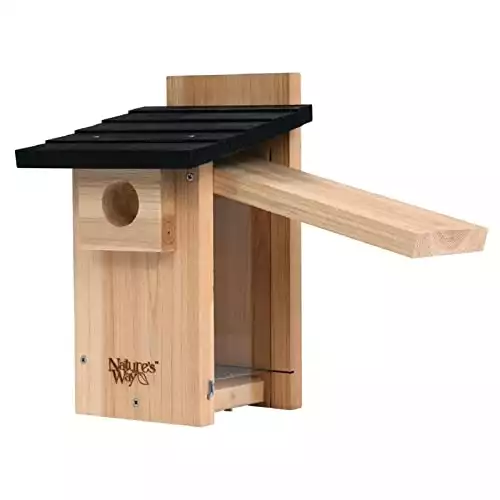One of the most effective ways bird lovers have helped bluebird populations thrive is by hanging bird houses. Naturalist Dick Peterson’s wooden bird house design is credited with helping restore bluebird populations in the 1960s and 70s. Today, we still use his signature sloped roof design for many songbird houses and nest boxes.
After almost a century of decline in the 19th and part of the 20th century, North American bluebird populations have made a comeback since the 1970s. This is due in part to legal protections like the Migratory Bird Treaty Act, and even the conservation of the backyard bird lover.
North American bluebird populations face a host of challenges, and providing a safe, ideal place for them to raise their nestlings has made a huge, positive impact.
Competition for nesting sites with invasive species like European starlings and house sparrows, habitat loss, poisons and pesticides all contributed to the previous decline of bluebird populations.
Luckily, there are a few things you can do to make sure our feathered friends have a fighting chance at survival, including buying a bluebird bird house. Below, we recommend 5 of the best bluebird houses to give a safe haven to these wonderful songbirds.
Top 5 Comparison Table
| Product Image | Product Name / Primary Rating / Pros | Primary Button |
|---|---|---|
|
||
|
||
|
||
|
||
|
- Very elegant design
- Excellent weather protection
- Certified by the National Audubon Society
- Designed following the guidelines of the North American Bluebird Society
- Predator resistant features
- Easy monitoring
- Innovative design that includes fledgling kerfs
- Clean-out doors and elevated mesh floors
- Predator protection
- Premium cedar and stainless steel hardware
- Predator protection
- Designed to attract both bluebirds and tree swallows
- Very attractive design
- Money-back guarantee
- The installation is hassle-free
Our Top 5 Picks in Detail
1. Woodlink Audubon Coppertop Cedar Bluebird House
- Cedar wood construction
- Sloping roof with copper cover
- Ventilation gaps
- Water drainage
- Secure closure
- Easy maintenance
The bluebird house is made from natural cedar wood and a coppertop roof which not only adds an attractive aesthetic element but also provides additional protection against weather elements. The sloping roof design extends past the entrance hole, directing water away from the entry to keep the interior dry.
The house features a 1-9/16″ entry hole that is fitted with a predator guard. This design helps to prevent predators from accessing the nest and harming the birds.
The front of the bird house opens, making it easy for users to access the interior and clean the house. This is particularly useful after fledglings have left the nest. A metal latch at the bottom of the front panel keeps it securely closed
A small slit at the back of the base allows water to drain from the house, preventing the accumulation of water that could harm the nesting birds.
Two holes on the back of the unit allow for easy mounting onto a post. Two included screws facilitate the installation process.
Pros
- Very elegant design
- Excellent weather protection
- Certified by the National Audubon Society
Cons
- Some users might not want to deal with the potential upkeep required for the copper roof, such as cleaning or preventing excessive patina development
2. Kettle Moraine Cedar Super Eastern Bluebird House
- Cedar construction
- Eastern bluebird-specific design
- Side opening viewing window
- Secure nesting site
- Ventilation and drainage
- Easy cleaning
- North American Bluebird Society approval
- Predator-resistant features
Made out of solid cedar wood, the Kettle Moraine bluebird house is a well-designed and thoughtfully crafted nesting box for bluebirds.
The copper portal around the entrance helps maintain the proper entry size for bluebirds (1 ½”), preventing predators from enlarging the entrance and gaining access to the nest.
The hinged door with a viewing window allows for easy observation of the nesting process without disturbing the birds. This is particularly important for monitoring the health and progress of the nestlings.
The design takes into account the safety of the nesting birds by preventing nestlings from falling out through the viewing window. This ensures a secure environment for the baby birds.
The sliding out viewing window facilitates easy access to the interior of the box, making it convenient to clean out old nesting materials and prepare the box for the next nesting season.
The fact that this bluebird house is approved by the North American Bluebird Society means it meets their standards for providing suitable nesting conditions for bluebirds.
Pros
- Designed following the guidelines of the North American Bluebird Society, in order to provide a suitable habitat for bluebirds
- Predator resistant features
- Easy monitoring through the side-opening viewing window
Cons
- Users might be disappointed if the bird house doesn’t provide adequate protection against extreme weather conditions
3. Nature’s Way Cedar Bluebird Viewing House
- Premium cedar construction
- Stay-clear, crack-resistant viewing window
- Elevated mesh floor
- Predator guard
- Fledgling kerfs
- Installation option
The birdhouse is crafted from premium cedar wood. The cedar wood is coated with a water-based protective stain. This stain helps to further enhance the durability of the bird house and protects it from the elements.
The bird house features a predator guard that extends the entrance hole. The stay-clear, crack-resistant window allows you to observe the nesting activities while it also protects the young inhabitants from falling out. Fledgling kerfs are incorporated into the design to provide extra grip for the young birds as they climb out of the nesting area when they’re ready to fledge.
The elevated mesh floor serves a specific purpose – it helps manage blowfly populations. Blowflies are pests that can threaten hatchlings, and the mesh floor aids in preventing their presence. Clean-out doors are provided to facilitate easy access for cleaning.
The bird house offers both pole mount and flush mount installation options. This versatility allows you to choose the installation method that works best for your outdoor space.
Pros
- Innovative design that includes fledgling kerfs
- The inclusion of clean-out doors and elevated mesh floors makes cleaning and maintaining the bird house more straightforward
- Predator protection
Cons
- The need to unscrew the latch that holds the door shut in order to remove the Plexiglas viewing window for cleaning is an inconvenience for users
3. Wild Wings WWCH3 Cedar Bluebird Box House
- Dual bird species attraction
- Air ventilation
- Predator guard
- Fledgling skerfs
- Easy cleaning
- Mounting versatility
Just like most of the options on our list, the bluebird house is crafted from premium cedar. An added predator guard is integrated into the design. This feature serves to extend the entrance hole and provides protection for young birds, helping to prevent potential predator attacks.
The design includes air vents that allow proper air circulation through wall and floor openings.
This option too comes with fledgling kerfs and clean-out doors that enable easy access for cleaning. This feature makes maintenance and preparation for the next nesting season convenient.
The versatile design allows for both pole mounting and flush mounting.
The specific design of the bluebird house is intended to attract not only bluebirds but also tree swallows.
Pros
- Use of premium cedar and stainless steel hardware
- Predator protection
- Users might appreciate that the bluebird house is designed to attract both bluebirds and tree swallows
Cons
- The roof tends to crack over time
5. Kingsyard Wooden Bluebird House
- High-quality natural wood
- Ventilation
- Elevated mesh floor
- Easy installation and cleaning
- Predator protection
- Observation windows
- 100% money back guarantee
The bluebird house is constructed with thick, solid wood walls made from New Zealand pine.
An extension from the entrance hole serves as a predator guard, providing added protection to young birds from potential predators. Clear, crack-resistant windows offer the benefit of bird-watching while acting as an additional protective layer.
Air vents are incorporated into the design to facilitate maximum air flow through both wall and floor openings. The interior of the bluebird house is equipped with a mesh floor; this type of floor helps with water drainage, ventilation and blowfly prevention.
Clean-out doors are provided to offer quick and effortless access for cleaning the interior of the bird house.
The inclusion of rust-free hardware and flush mount options simplifies the installation process. The birdhouse arrives ready to install, making setup convenient.
Pros
- Very attractive design
- The presence of a satisfaction guarantee provides users with confidence in their purchase, knowing that they can seek a refund or replacement if not fully satisfied
- The installation is hassle-free
Cons
- New Zealand pine is not as durable as cedar wood
What kind of house do bluebirds like?
Bluebirds are cavity nesters, so they prefer four-sided bird houses with a circular entrance hole. All three species of bluebirds in North America like the same type of bird house, but both Western bluebirds and Mountain bluebirds prefer a slightly larger entrance hole.
Which type of bluebird you have in your backyard is determined by your location.
- Eastern bluebirds are found east of the Rocky Mountains
- Western bluebirds are found west of the Rocky Mountains
- Mountain bluebirds are found exclusively in the Rocky Mountain range
Bluebirds prefer woodpecker holes over all other nesting options, so a properly constructed bluebird house is essential for attracting bluebirds.
Your state’s chapter of the North American Bluebird Society will typically have nesting boxes for the specific species in your area. You can also purchase one of the bluebird houses we recommended in this article.
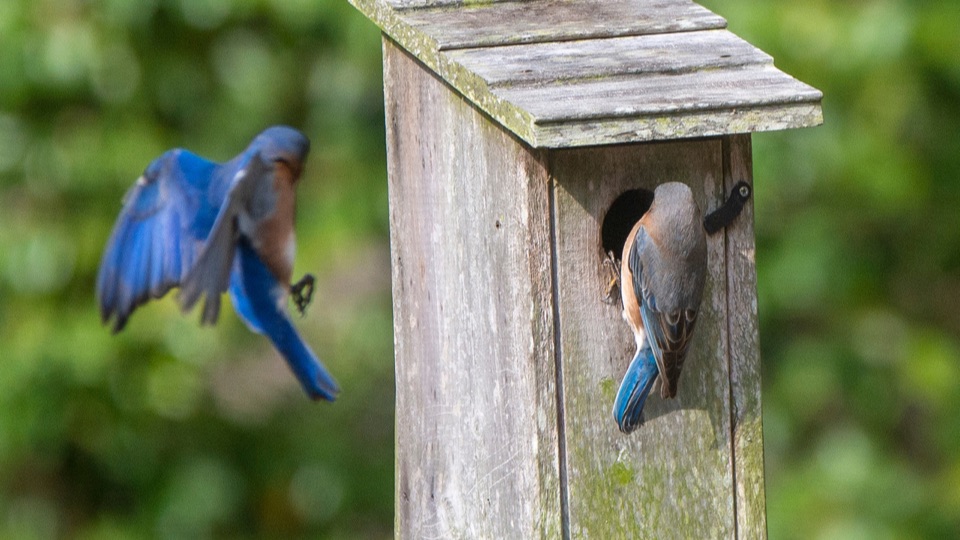
What are the dimensions of a bluebird house?
- Entrance Hole: For Eastern bluebirds, the entrance hole should have a diameter of about 1.5 inches (3.8 centimeters). This size allows bluebirds to enter comfortably while excluding most competing bird species.
- Floor Dimensions: The floor of the bluebird house typically measures around 4 x 4 inches (10 x 10 centimeters). This provides enough space for the bluebird pair to build their nest and raise their young.
- Interior Height: The interior height of the bluebird house is typically around 8 to 10 inches (20 to 25 centimeters).
- Depth: The depth of the bluebird house, from the front (where the entrance hole is) to the back, is often about 6 to 8 inches (15 to 20 centimeters).
- Roof Overhang: The roof of the bluebird house should extend over the front slightly, providing an overhang to shield the entrance hole from rain and direct sunlight.
What materials do I need for a DIY bluebird bird house?
Cedar bluebird houses naturally resist rotting and insect infestation, but you can also make yours out of redwood, pine, or even PVC.
PVC bluebird houses are quick and easy to make and cost-effective. You will need:
- A 4” or 6” diameter PVC pipe 10 inches long
- PVC female adapter (make sure to get the correct diameter for your pipe)
- PVC cleanout plug that fits the female adapter
- PVC snap drain
- 1” by 6” by 9” untreated wood (roof)
- PVC glue (Gorilla clear PVC clue is low odor and safer for wildlife)
Instructions for building a bluebird house
Step 1
Drill an entrance hole approximately 3 ½” from the top of the PVC pipe. Entrance holes should be around 1 ½ inches for eastern or western bluebirds, and slightly larger (9/16 inches) for mountain bluebirds.
Step 2
Cut the rim off the snap drain. This will make it easier to attach to the roof later.
Step 3
Screw snap drain to the underside of the roof piece. Make sure the screw heads are larger than the drain holes.
Step 4
Use PVC glue or cement to glue your snap drain in place on the top. Remember the glue dries fast so put the pieces together quickly.
Step 5
Glue female adapter to the bottom.
Step 6
Drill a few small holes in the cleanout plug for drainage, then attach it to the female adapter.
Once your PVC birdhouse is ready, mount on a 1/2-inch pole 4-6 feet high.
Do I need a predator guard for my bluebird house?
Yes. Using a predator guard has been shown to increase the nest survival rates of birds using nesting boxes and birdhouses. When multiple predator guard types were used, nesting success was even higher.
Cavity nesters like bluebirds are at risk of predators. With only one entrance hole, a predator like a raccoon, snake, or even a domestic cat can simply reach in and take eggs or nestlings.
Adding at least one predator guard helps protect wild birds from predators. Using multiple predator guards is more effective, making your birdhouse safe for nesting birds.
Avoiding perches will help keep your birdhouse sparrow resistant. Notches inside and outside just below the entrance hole will give bluebirds a place to grip without putting them at risk from predators.
Baffles and entrance hole extenders are also great predator guards. When used together, they are even more successful at keeping predators out of bluebird nest boxes.
When should I put up a bluebird house?
It’s best to install the bluebird house a few weeks before the bluebirds in your area start nesting.
For Eastern bluebirds in North America, which are one of the most common species to attract with a bluebird house, the ideal time to put it up is typically in late winter or early spring. This gives the bluebirds ample time to find and become familiar with the nesting site before the breeding season begins.
In warmer southern areas, bluebirds will start their breeding season as early as mid-February. In cooler climates, they may wait as late as April.
Regardless of when the breeding season starts, all North American bluebird species have a breeding season of approximately 83 days long.
In the fall, you can clean out nesting materials. Even though bluebirds will use the birdhouse year-round, they are messy birds who are known to build nests on top of old nests.
Cleaning out nesting materials at the end of breeding season makes for a healthier nest box for next year’s babies.
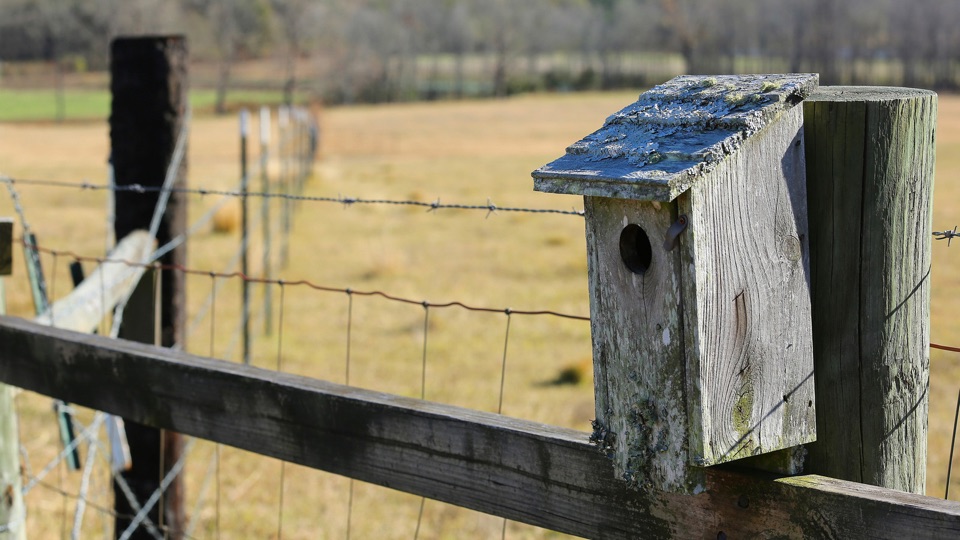
Where is the best place to put a bluebird house?
The best place to put a bluebird house is in an open area, mounted on a pole that is ½” in diameter, a mounting practice that is called the Gilbertson system.
Mounting bluebird houses on a pole in an open area keeps bluebirds safe from predators that might use a tree or fence post mountings to access young birds. The Gilbertson system has consistently produced more successful bluebird fledglings than the Peterson style box alone.
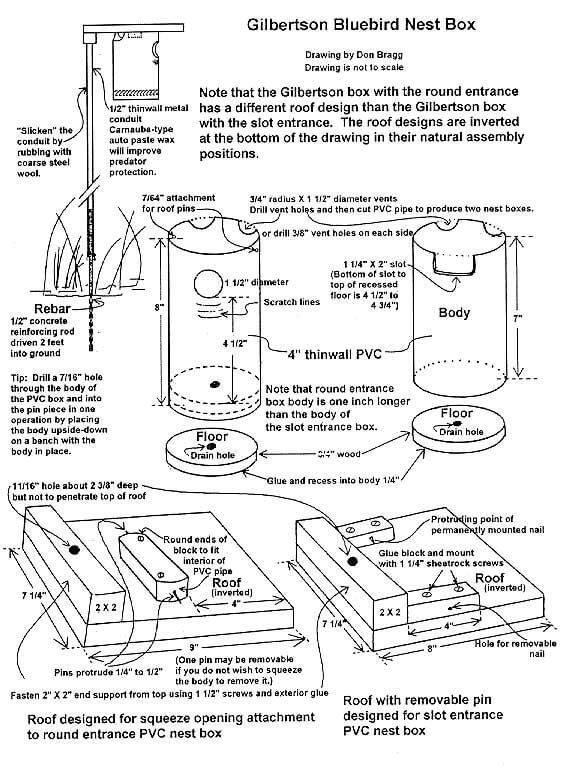
It’s important that your bluebird house faces away from prevailing wind. Where you live will determine which direction the strongest winds come from, but in most of the USA, bluebird houses face east or northeast.
Here are some other key factors to keep in mind:
- Sunlight and Shade: Bluebird houses should be placed in an area that receives a good amount of sunlight during the day but also offers some shade to prevent the nest from overheating. Placing the house with the entrance facing east or southeast helps avoid direct sunlight during the hottest parts of the day.
- Clear Flight Path: Ensure there is a clear flight path leading to the entrance of the bluebird house. Avoid placing it too close to branches, shrubs, or other obstacles that could obstruct the birds’ access to the nest.
- Open Area: Bluebirds prefer open spaces with a mix of grassy areas and perching spots nearby, such as wires or tree branches. This allows them to easily spot insects, their primary food source, and reduces the likelihood of predators sneaking up on the nest.
- Human Activity: While bluebirds are relatively tolerant of human presence, try to avoid placing the house too close to high-traffic areas or areas with frequent disturbances to give the birds some peace during the nesting season.
- Nest Spacing: If you plan to have multiple bluebird houses, ensure they are placed at least 100 feet apart to avoid territorial conflicts between bluebird pairs.
How high should I hang a bluebird house?
The National Audubon Society recommends placing bluebird nest boxes and birdhouses 4-6 feet high.
Watch our video on how to attract and what to feed bluebirds!
Which way do you face a bluebird house?
When facing a bluebird house, the entrance hole should be oriented towards the east or southeast. This means the front of the bluebird house, where the entrance hole is located, should face eastward or in the general direction of the southeast.
Facing the bluebird house in this direction provides several benefits for the nesting birds:
- Sunlight: By facing east or southeast, the entrance hole receives morning sunlight.
- Shelter from Afternoon Sun: Placing the entrance away from the west or southwest direction helps avoid direct sunlight during the hottest parts of the day.
- Wind Protection: Orienting the entrance away from prevailing winds provides some protection from strong drafts and chilly air, creating a more favorable nesting environment.
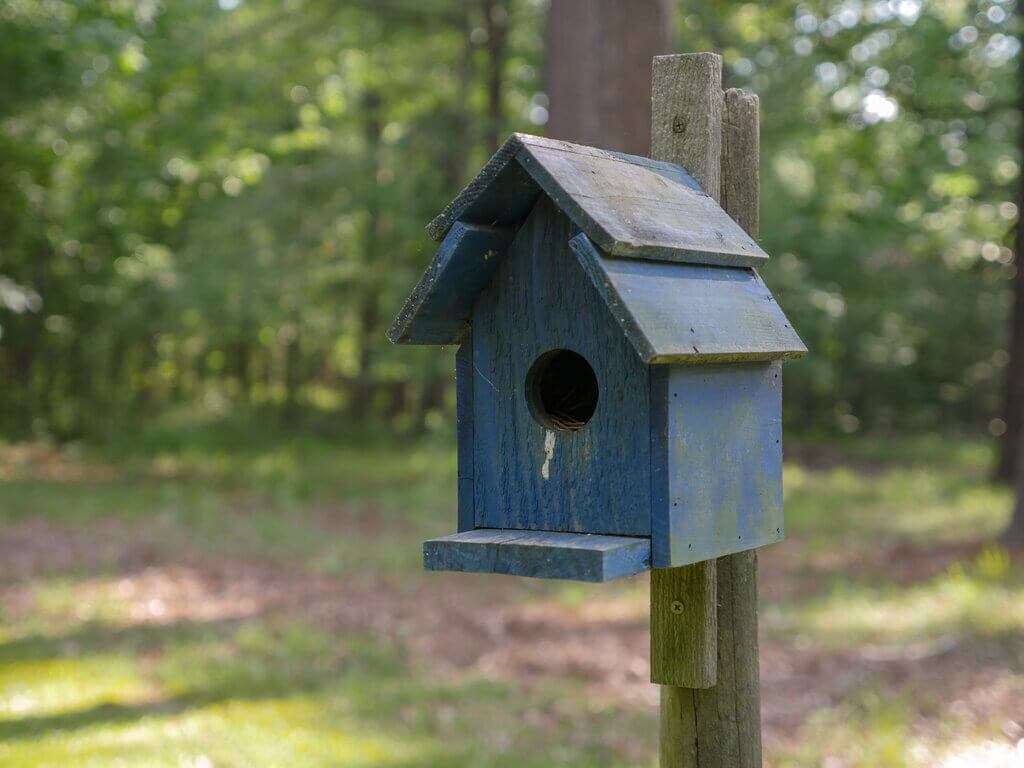
What color should a bluebird house be?
The traditional and most recommended color for a bluebird house is light blue. The light blue color helps attract bluebirds to the house because it mimics the appearance of natural cavities that bluebirds seek out for nesting in the wild.
What to read next: The Best Feeders To Attract Bluebirds To Your Yard!

